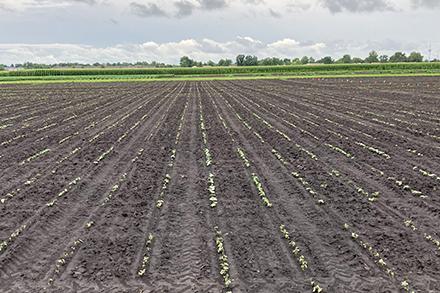Making the “SnAP” Count
Whether the recipe calls for green beans, string beans, wax beans, or Italian beans, each belongs to the same crop group known as snap beans–named for its audible “snap” when the ripe green bean pod is broken.

Rows of young snap bean plants peek out just above the soil as they begin to sprout, three weeks after planting (Image courtesy of Nicholas Hausman).
ARS scientists at the Global Change and Photosynthesis Research Unit in Urbana, IL, and the Grain Legume Genetics Physiology Research Unit in Pullman, WA, are studying a large and diverse group of snap bean lines collectively named the Snap Bean Association Panel (SnAP). In collaboration with researchers from Cornell University and Oregon State University, their goal is to identify genes associated with crop tolerance to stressors, while breeding a higher quality and more productive crop.
“Snap bean breeders are using new knowledge gleaned from studying the panel of diverse snap beans to improve the crop,” said Martin Williams, an ecologist at the ARS Global Change and Photosynthesis Research Unit. “Our recent research sheds light on how to improve pod shape and size.”
“Initially, we investigated how snap bean tolerates herbicides that are not available for use in the crop but would provide much needed weed control,” he added. “Our more recent research focuses on improvements to snap bean eating quality.”
According to Williams, SnAP enables ARS to generate new knowledge about the crop by examining diversity in the crop’s genetic makeup. The genetic diversity panel reveals not only a snap bean pod’s uniformity, but also the crop’s tolerance to herbicides, resistance to diseases, or changes in the environment.
Ana Saballos Espinal, an Oak Ridge Institute for Science and Education Fellow at ARS, is exploring important yield and vegetable quality traits in snap bean. Saballos Espinal has been working with Williams’ team since 2020.
“Pod shape is critically important in the commercial market and there is a lot of interest in creating new cultivars,” said Saballos Espinal. “One reason to breed for improved cultivars is that the environment is always changing, pathogens are changing, climatic conditions are changing, and consumers want a tasty, attractive product that is grown sustainably.”
In addition, there are very specific food quality standards that crops must adhere to for the commercial market.
“When a truck load comes from the field into the processing plant, pods with specific length and thickness are marketable,” said Saballos Espinal. “Pods not meeting those standards are discarded, which can result in economic loss.
“Every time a new cultivar is created, not only must all the characteristics adapt to changes in the environment, but food quality standards must be met,” she continued. “No matter how productive or adaptable the cultivar is, if the product does not meet the standards, it is not going to be adopted by the marketplace.”
Another feature important to the producer is uniformity of the pod.
“That is a challenge plant breeders have when they are trying to create a new cultivar,” Saballos Espinal added. “We tend to limit ourselves to a narrow set of high-quality material to produce new varieties. The downside to that strategy is that you don’t have a lot of genetic diversity in the crop. To counter this trend, we need to introduce a wider set of genetics into commercial germplasm. By investigating the genetically diverse SnAP panel, we can identify cultivars and genes of interest to help breeders diversify their breeding pool.”
Over time, ARS researchers aim to unlock even more insights to guide plant breeders and growers toward new varieties and cultivation practices.
“Research on the snap bean diversity panel can shed light on potential mechanisms conferring crop response to stresses from management and the environment,” said Williams. “Some of these mechanisms are likely to be valuable in studying other plant species, too.” By Tami Terella-Faram, ARS’s Office of Communications.

